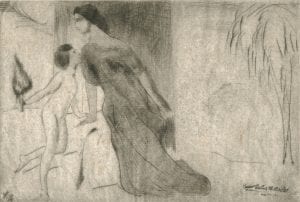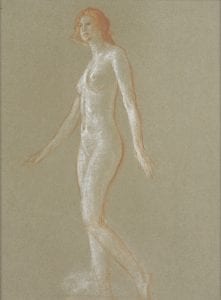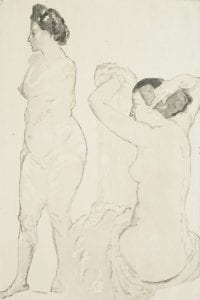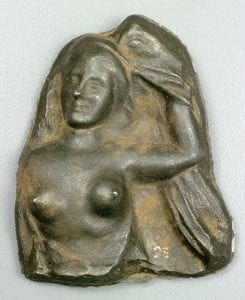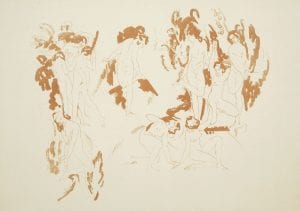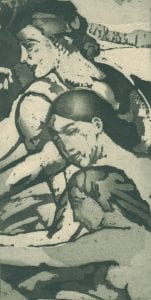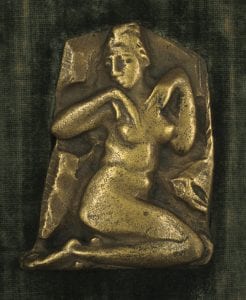
- This event has passed.
Contradiction and Classicism

The Prints of Arthur B. Davies
Curated by Christine I. Oaklander, Ph.D.
Artist and impresario Arthur B. Davies (1862-1928) presents a study in 20th century contradiction. Impeccably dressed and well-groomed, Davies looked more like a sedate banker or professor than an artist; yet for decades he maintained a double life, dividing his time between a family in rural New York and a mistress and daughter in New York City. A scholar and collector of Greek and Roman antiquities, Davies also acquired work by vanguard artists Picasso and Matisse, and was a prime mover in the 1913 Armory Show. Although better known today as a key figure behind the founding of the Museum of Modern Art, during his lifetime he was considered by many critics, artists, and collectors as the most prominent living American artist. Through an examination of his graphic work, Contradiction and Classicism: The Prints of Arthur B. Davies sheds light on the brilliant, searching mind and complex character of this talented artist and arts promoter.
The exhibition highlights almost two dozen prints, drawings, and sculptures selected from some fifty works donated to Lehigh University in 1971 by the artist’s daughter-in-law Erica Davies. A superb draftsman and printmaker, Davies created more than 200 prints over four decades, most of them devoted to the ideal female form, but also experimenting with cubism and color abstraction. Today, examples of his work are held by dozens of museums across the country and a number of books and exhibition catalogues have been published. Yet, the full story of Arthur B. Davies as an artist, advocate, and person remains shrouded with mystery.
Contradiction and Classicism: The Prints of Arthur B. Davies
by Christine I. Oaklander, Ph.D., curator
Antiquarian collector, or prime mover behind the founding of the Museum of Modern Art? Father figure and farmer, or urbanite engaged in a clandestine affair with his model? Eighty-six years after his death, a full comprehension of Arthur Bowen Davies (1862-1928) as an artist, arts impresario, and individual remains elusive. Gertrude Kasebier?s portrait offers no clue to Davies? fascinating and turbulent life and career, presenting a man described by his colleagues as looking more like a college professor or banker than an artist. And yet, Davies was arguably the most famous American artist of his day, with scores of exhibitions and publications, and wealthy collectors vying for his mysterious, symbolic compositions.
Davies explored an amazing spectrum of mediums and techniques including sculpture (additive and subtractive), painting (easel and mural), graphics (prints and drawing), and textiles (tapestry). His strongest thematic currents are ancient rather than modern, classical rather than abstract. Paramount was the depiction of the female nude engaged in dance or carefully posed, inspired largely by ancient Greek and Roman art and the classically-inspired contemporary dances of Isadora Duncan and Ruth St. Denis. Although Davies produced over 2,000 works, his fundamental themes and compositions remain constant. What are we to make of these processions of classicized female nudes? On the surface, they seem simple, repetitious, and perhaps easy to dismiss. However, Davies? activities reward closer investigation and, not unlike his biography, yield many surprises.
The prints exhibited here were gifted to Lehigh University by Davies? daughter-in-law Erica. Davies made over 200 prints during his career, experimenting with techniques and materials, working and reworking his print plates. He typically employed master printmakers, specialists in specific print techniques, selecting special inks and quality papers in a variety of weights and colors, some of them antique.
Arthur B. Davies grew up in Utica, a small city in central New York. By age five, he manifested a strong interest in art and a fascination for experimenting with mediums and techniques. Enlightened parents encouraged Davies by providing lessons with a local landscape painter. His early work, inspired by the Hudson River School artists, depicts the surrounding rural landscape populated by farm animals, women, and children A gifted draftsman, Davies? youthful oeuvre consists of pen and ink and pastel drawings and watercolors. By the mid-1880s he made his first prints, with subjects closely related to his drawings and watercolors.
In 1886, Davies gained his first significant exposure to ancient Greek and Roman art when he enrolled at the Art Institute of Chicago. Founded in 1878 as a museum and school, the first works to enter the Institute?s collection were casts of ancient Greek and Roman sculpture, used as models for figure drawing in the Antique Class. With funds earned in painting a Civil War cyclorama, in 1887 Davies decamped for New York City, where any young and ambitious American artist was drawn like the proverbial moth to a flame. There he sampled rich cultural offerings in the way of dance, music, theatre, and art exhibitions, garnering pure enjoyment and artistic inspiration. Classes at the Art Students League enabled Davies to build a network of friends and colleagues, among them his teacher Kenyon Cox. Cox introduced Davies to the work of Puvis de Chavannes, the contemporary French Symbolist painter of ethereal female figures set in sylvan landscapes, who exerted a profound influence on his art. Another friend was classmate and dancer Edna Potter; in 1902 he hired Edna to model and by 1905 she had become his mistress and muse. Living in the city during the week with Edna under an assumed name, Davies spent weekends with his wife Virginia and their children at the ?Golden Bough,? their farm in Rockland County.
In 1893, Davies? first solo exhibition, featuring lithographs, was presented to favorable reviews at the well-respected Keppel Gallery in New York. In 1894 he met Keppel?s former assistant, William Macbeth, who became his intimate friend and principal dealer, championing his work in dozens of solo and group exhibitions, introducing him to major collectors, and securing exhibitions for him in other cities and abroad. In 1895 Macbeth sent Davies to Europe as his purchasing agent. Travelling to France, England, and Holland for the first time, he visited galleries, museums, studios, and private collections, viewing historical masterpieces and contemporary art. It is possible that Davies began collecting for his own education and enjoyment during this time, a practice that became a lifelong obsession. Dutch masters like Rembrandt and de Hooch, and Italian Renaissance painters like Giorgione and Botticelli were particularly compelling. Like Rembrandt, Davies? prolific printmaking career paralleled his painting career. In fact, several of his prints and paintings had closely related or even identical compositions, bearing the same titles.
By the first decade of the twentieth century, Davies had conquered the competitive New York art world, with a series of exhibitions and sales to wealthy collectors. His classically beautiful female nudes in tranquil landscapes were compelling at a time when disease, crime, and labor unrest were prevalent in urban centers. Despite this mainstream success, in 1908 Davies joined forces with a group of mutinous artists disgusted with the country?s exclusionary arbiter of success, the National Academy of Design. In April 1907, thirty-three artists were proposed for membership in the Academy; thirty were rejected, among them Davies. In February 1908 a group of the rejects organized an exhibition at Macbeth Gallery devoted largely to scenes of gritty slum life in New York. Although hardly consonant with the urban realism displayed by five of the eight artists, later dubbed ?The Ashcan School,? Davies? paintings were given equal treatment at the show, which attracted national attention. Concurrently, Davies began visiting the modernist exhibitions presented by Alfred Stieglitz at ?291? gallery. Stieglitz was the first American gallerist to show avant-garde European artists like Matisse, Cezanne, Picasso, and Americans John Marin, Alfred Maurer, and Arthur Dove. His encounters with revolutionary art and ideas fed Davies? hunger for experimentation and challenge, culminating in his visionary leadership of the 1913 Armory Show. A survey of 1,400 works by European and American artists beginning with Goya and ending with Picasso, this was the first large-scale public presentation in America of European modernist ?isms? like Cubism and Fauvism, and it touched off a national media frenzy.
For several years after the Armory Show, Davies experimented with modernist principles in painting, printmaking, and sculpture. Rather than adopting the fractured planes, skewed perspective, and disassembled forms of pure Cubism, Davies ?cubified? his characteristic themes. In 1917 he became active in The Penguin, an avant-garde exhibiting group convened by Walt Kuhn, his lieutenant in the Armory Show. Davies contributed to Penguin shows and attended their bohemian costume balls. He also donated a printing press, and helped several members learn printmaking. Some of Davies? cubist prints were probably created at The Penguin, a couple of blocks north of the revolutionary arts community in Greenwich Village.
During his lifetime, Davies was a frequent traveler, in the mid-1920s spending summers painting landscapes in Europe. In November 1928, he suffered a fatal heart attack in Italy. Virginia, who only then learned about Davies? second family, destroyed dozens of unfinished paintings in a bonfire. In April 1929, she sent his collection to the block in a three-day sale at New York?s leading auction house. The catalogue lists 450 works, ranging from Assyrian and Babylonian relics and Greek pottery to symbolist and romantic works by William Blake and Puvis de Chavannes; and modernist European and American art by Picasso, Brancusi, Matisse, Max Weber, Marsden Hartley, and Patrick Henry Bruce. Asian, Middle Eastern, and French decorative arts were also represented. Major dealers and collectors vied to snap up the rarities. The auction catalogue, which is the only official record of his collection, is a symbol for the experimental and secretive spirit of this brilliant artist and individual.
Christine I. Oaklander, Ph.D. is an independent art historian with an expertise in early American modernism and the Armory Show. She was formerly Director of Collections and Exhibitions at the Allentown Art Museum, and Arts Coordinator for Lehigh Valley Health Network.






